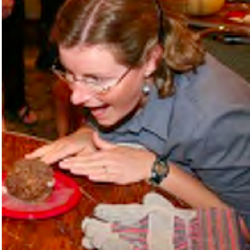Source Institutions
Source Institutions
Add to list Go to activity
Activity link broken? See if it's at the internet archive

In this activity (on page 5 of PDF), learners use dry ice and household materials to make scientifically accurate models of comets. Learners will investigate the ingredients in comets and how comets could have contributed to water ice on the Moon that the Lunar Crater Observation and Sensing Satellite (LCROSS) Mission launched in 2009 is designed to detect. This activity can be used as a demonstration or groups of learners can make their own comets. Adult supervision is recommended. The PDF contains step-by-step instructions, photos, presentation tips, extensions and links to background information.
- 10 to 30 minutes
- 10 to 30 minutes
- $5 - $10 per group of students
- Ages 6 - adult
- Activity, Demonstration, Lesson/Lesson Plan, Model
- English
Quick Guide
Materials List (per group of students)
- Measuring cup
- Large spoon
- Mixing bowl
- 4 black garbage bags
- Newspapers
- Work gloves (gardening gloves with nubs or heavy leather work gloves)
- Protective goggles
- Hammer
- Heat lamp (optional)
- Dry Ice
- Ammonia (or window cleaner that contains ammonia)
- Dark corn syrup (or cola – with sugar – don’t use diet)
- Water
- Dirt or sand
Subjects
-
Earth and Space Science
-
Astronomy
- Probes, Satellites and Spacecraft
-
Solar System
- The Moon
- Asteroids and Comets
- Origin of Solar System
-
Astronomy
-
Mathematics
- Measurement
-
Engineering and Technology
-
Engineering
- Aerospace Engineering
-
Engineering
-
Physical Sciences
- Chemistry
-
States of Matter
- Solids
- Liquids
- Gases
- Changes of Phase
-
Structure and Properties of Matter
- Elements and Periodic Table
-
The Nature of Technology
-
Technology and Society
- Impacts of Technology
-
Technology and Society
Informal Categories
- Model Building
Audience
To use this activity, learners need to:
- see
- touch
Learning styles supported:
- Involves teamwork and communication skills
- Involves hands-on or lab activities
Other
Components that are part of this resource:
This resource is part of:
Access Rights:
- Free access
By:
Rights:
- All rights reserved, Astronomical Society of the Pacific,
